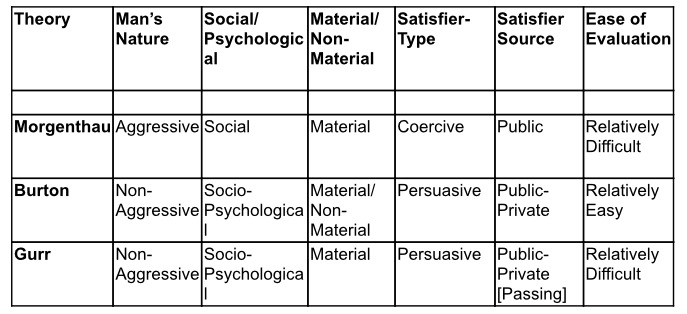Are People Naturally Aggressive?

|
Author: Mark Miceli-Farrugia |

|
Dated: 2019-01-24 |

|
Uploaded: 2019-01-24 |
Are people naturally aggressive? Is that why there is so much violent conflict in the world? Imagine a three-cornered discussion of this question by Hans Morgenthau, John Burton, and Ted Gurr. What would each theorist say in response? How might they reply to each other? State in a concluding paragraph or two whose approach you prefer and why. (1000 words due by noon on Sunday, October 18)
Submitted by Mark Miceli-Farrugia on the 18 October, 2015
Until fifteen years ago, aggression was simplistically defined as an “unprovoked attack on another: the manifestation of the will to assert power over or hostile feelings toward others.” (1)
What has changed? Well, conflict resolution has since graduated from an art into a social science. Various scholars have sought to understand the external and internal factors which motivate or condition the incidence of violence. Morgenthau, John Burton and Ted R. Gurr are but three of these. We shall explain the theory of each one of these scholars. We shall subsequently compare and contrast them, prior to expressing our preference.
Hans Morgenthau’s Theory of ‘Power Politics’
Evaluation of Mankind: Morgenthau, the founding father of Twentieth Century Political Realism (2), was a Conservative Personalist who viewed humans negatively as creatures driven to engage in violent conflict by lust for political power. (3)
Motivating Principles: For Morgenthau, men are governed by the principle of self-interest as reflected in political power: they cannot therefore be expected to make “a continual sacrifice of all views of private interest, or advantage, to the common good.” (4) In Morgenthau’s theory, power is implicitly viewed in monetary – material - terms. Morgenthau recommended that nation-states, themselves interested in the pursuit of power, should form power blocs and should resort to war (violence) as a continuation of politics. (5)
Social Influences: Morgenthau concedes that “the content (of power) and the manner of its use are determined by the political and cultural environment.” (6) Consequently, self-interest is also conditioned by the external environment.
Coercive Deterrence: Like his fellow-Personalists, Morgenthau viewed the non-conforming parties as adversaries. He believed that objectionable behaviour can be modified coercively via “deterrence” – the administration of pain. (7)
John Burton’s Theory of ‘Basic Human Needs’
Evaluation of Mankind: John Burton was a Liberal Situationalist who benignly considered man as peace-loving and not solely motivated by material gain. Burton did, however, recognize that man is not always humanly capable of conforming to the sometimes oppressive demands of social norms and institutions.
Motivational Principles: Burton believed that man is primarily motivated by four basic human needs – identity, recognition, security, and personal development – the first two being the most critical. (8) It is worth noting that Burton conceived his basic needs in both material and non-material terms.
Structural Infuences: Burton highlights that, within our legally proscribed societies, the structural means of material and non-material acquisition may often be as conflict-inducing as the ends. (9)
Structural Adjustments: Burton maintains that, when the dignity of a large number of community members is systematically frustrated, structural changes – adjustments to norms and institutions – may be required. If not, the community might resort to intrastate conflicts - gang warfare, city riots or terrorism - or even interstate terrorism and wars of an ethno-nationalistic or ethno-religious nature. (10)
Persuasive Cooperation: Like his fellow-Situationalists, Burton believed that the two or more contending parties needed to cooperate respectfully and persuasively, by providing ab initio due recognition to all the parties concerned. (11) According to Burton, objectionable behaviour can be modified via “positive reinforcement” – the administration of pleasure. (12)
Ted R. Gurr’s Theory of ‘Relative Deprivation’
Evaluation of Mankind: Ted R. Gurr is, like Burton, a Liberal Situationalist whose perceptions of man are essentially benign and whose explanation of violence is also socio-psychological in nature.
Motivational Principles: According to Gurr, a potential cause for social conflict is Relative Deprivation - “the community’s perception of discrepancy between their value expectations (VE) - conditions of life to which members believe they are rightfully entitled – and their value capabilities (VC) – the goods and conditions members have actually attained." (13) Cases of extreme discrepancy between VE and VC might elicit “political violence such as rioting, terrorism, civil wars and other instances of social deviance such as crime.”(14) The individual or group might compare itself with its own past conditions or with a social group with which it relates.(15)(16) Where sought and attainable value positions are in approximate equilibrium, they can be regarded as ‘normal’. Where discrepancy exists one gets ‘disequilibrium’. Disequilibrium, when extreme, may provoke violence.
Socio-Psychological Explanations: Gurr cites Dollard’s “most influential” formulation of frustration-aggression theory: "the occurrence of aggressive behaviour always presupposes the existence of frustration and contrariwise, that the existence of frustration always leads to some form of aggression.” (17) Gurr mentions four response patterns found in an examination of frustration-induced behaviours in a New Guinea tribe: submission; dependence; avoidance; and aggression. (18) Gurr notes that aggressive responses tend to occur only when they are evoked by an external cue, that is, when the angered person sees an attackable object or person that he associates with the source of frustration. (19)
Conflict Resolution Strategies: There are three distinct patterns of disequilibrium, the first usually found in static societies, the latter two experienced in societies undergoing substantial socio- economic change (20):
a. Decremental Deprivation: in which a group’s VE remain relatively constant but VC are perceived to decline. This is most common in traditional societies where right-wing putsches might be the outcome.
Recommended Solution: Promote public/private investment and mildly increase expectations.
b. Aspirational Deprivation: in which VC remain static while VE increase. This usually provokes the urban drift and middle-class upheaval.
Recommended Solution: Promote public/private investment and mildly reduce expectations.
c. Progressive Deprivation: in which there is a substantial and simultaneous increase in VE and decrease in VC. This situation preceded the French, Russian and American Civil Wars, the Nazi Revolution and the Egyptian Revolution of 1952.
Recommended Solution: Promote public/private investment and mildly reduce expectations.
Effective Economic Planning: The passing conclusion of Gurr’s analysis is that Government’s should seek to under-promise and over-deliver. In fact, Gurr concludes that “men are quick to aspire beyond their social means and quick to anger when those means prove inadequate, but slow to accept their limitations.” (21)
My Preferred Approach I am summarizing below the essential characteristics of the three need/frustration theories we have just discussed:

I prefer Burton’s theory because it essentially tallies with my view that man:
1. is essentially non-aggressive;
2. is conditioned by both social and psychological factors;
3. is rewarded or frustrated by both material or non-material circumstances;
4. is satisfied more enduringly by persuasive rather than coercive factors;
5. is motivated by a combination of public and private incentives; and
6. is generally stirred by theories which are relatively easy to understand and apply.
Mark Miceli-Farrugia - 18 October, 2015
-----o-o-o-----
References
(1) Douglas H Yarn (ed), ‘Dictionary of Conflict Resolution’, Jossey-Bass Inc., 1999
(2) Hans Morgenthau, ‘Politics Among Nations: The Struggle for Power and Peace’, Fifth Edition, Revised, Alfred A. Knopf, New York, 1978
(3) Richard Rubenstein, ‘Basic human needs: the next steps in theory development’, The International Journal of Peace Studies, Spring 2001
(4) Hans Morgenthau, op.cit.
(5) Hans Morgenthau, ibid.
(6) Hans Morgenthau, ibid.
(7) Richard Rubenstein, op.cit.
(8) John Burton, ‘Conflict Resolution – The Human Dimension’, The International Journal of Peace Studies, January 1998
(9) John Burton, ibid.
(10) John Burton, ibid.
(11) John Burton, ibid.
(12) Richard Rubenstein, op.cit.
(13) Ted Robert Gurr, ‘Why Men Rebel’, Princeton University Press, 1970.
(14) Robert K. Merton, ‘Social Structure and Anomie’, American Sociological Review 3: 672-82, 1938
(15) Ted Robert Gurr, op.cit.
(16) Three other concepts are frequently employed in the analysis of disruptive collective behaviour. Although not directly analogous to RD, they appear to be alternatives:
• Cognitive Dissonance in Leon Festinger’s ‘A Theory of Cognitive Dissonance’, Stanford, Stanford University Press, 1957;
• Anomie in Robert K. Merton’s ‘Social Structure and Anomie: Continuities’, Social Theory and Social Structure, New York, The Free Press, 1957; and
• Conflict in Johan Galtung’s ‘Institutionalized Conflict Resolution: A Theoretical Paradigm, Journal of Peace Research, No. 4, 1965, 348.
(17) John Dollard and others, ‘Frustration and Aggression’, New Haven: Yale University Press, 1939
(18) Marie Lazarfeld and Hans Zeisal, ‘Die Arbeitslosen von Marienthal’ Psychologische Monographen, v (1933)) summarized in Himmelweit, 172
(19) L. Berkowitz, ‘The Concept of Aggressive Drive”, and S. Feshbach, ‘The Function of Aggression and the Regulation of Aggressive Drive’, Psychological Review, LXXI, July 1964, 257-272.
(20) Ted R. Gurr, op.cit.
(21) Ted R. Gurr, op.cit.

Ratings